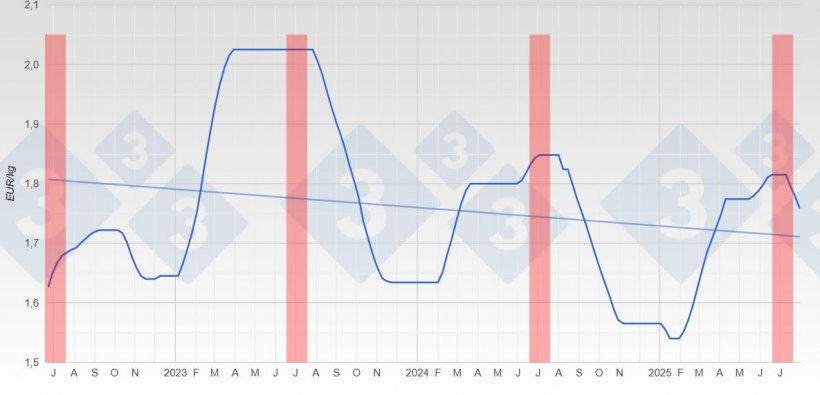The apparent firmness of Spanish pig prices (which a month ago was certain) has collapsed this July. So far, we have seen three consecutive drops in the reference market price (-0.02 euros, -0.017 euros, -0.02 euros), as a prelude to what is yet to come. It is exceptional for pig prices to fall in Spain during the month of July.
So far this year, around 3% more pigs have been slaughtered in the EU compared to last year. In addition, the average carcass weight has been higher. On top of this increase in pork production, exports to third countries are compromised and made difficult by a very strong euro and the extreme aggressiveness of Brazil. The consequence of all this is that there is much more meat available within the EU's borders. And it turns out there is no market for such availability: consumption is not growing.

The cherry on top came from Germany, which lowered its carcass price by 15 cents per kilogram on Wednesday, July 2. This move triggered decreases in the pig price in all the countries surrounding Germany, and the pork market followed suit, beginning a price decline that still hasn't ended.
From July 2 until today, Spanish pig farmers have been receiving—and still receive—no less than 30 euros more, net, for a 116-kg live pig than any of their German counterparts... This doesn’t seem consistent with being part of a so-called single market, though everyone is entitled to their opinion...
Although Germany lost its position as the European leader in pig slaughter a few years ago (to Spain), it still holds a prominent position in Northern Europe, influencing neighboring markets through extensive trade in both live pigs and pork. In other words, the German price pulls those of its neighbors along.

The first drop in the Spanish price occurred at a time when equivalent live prices showed a difference of 28 euro cents per kilogram in favor of Spain compared to Germany. A gap of that magnitude cannot last more than a few weeks; considering the results of Spanish slaughterhouses, the situation was completely unsustainable, and the price fell. We attribute this drop to sensibility and common sense: the chronic shortage of livestock due to Spain’s excess slaughter capacity was not enough to sustain an unviable live price. Today, exports are the guiding light of Spanish pig farming: we must not forget that we export more than half of the pork we produce. Exporting is essential, and if the flow to foreign markets is disrupted, serious and undesirable consequences could follow. If exports suffer, everything becomes more complicated; if exports were to disappear, everything would become impossible.
We’ve seen cascading price drops in certain cuts (mainly loins but also shoulders…), which have further eroded the margins of Spanish slaughterhouses that were already in the red, as we noted in our previous commentary. Never before has so much been lost from slaughtering and cutting pigs in Spain as in the recent week 29.
We believe that prices (both for pigs and pork) will fall and continue to fall until they find solid ground. We don’t know where that bottom is… no one does.
When doubt overwhelms us and uncertainty seeps into our mindset, we must try to keep a cool head and look at things with as much perspective as possible. In that regard, it’s very useful to observe what’s happening around the world.
- Brazil keeps its pig prices well below European levels: inevitably, it is taking and will continue to take market share from us in exports to third countries. For now, this is a hard truth.
- Our Spanish price remains one or several steps above those of our EU partners; in a situation where German slaughterhouses are reporting significant losses with much cheaper pigs… we can expect nothing else for the Spanish pig price but for it to fall, and then fall again.
- The advantage that EU protectionism represents for Spanish production is fading and disappearing: the excess pork that must remain in Europe is forcing significant price drops. We haven’t reached the end. Yet.
- It’s unlikely that the relentless flow of European pork into an already saturated EU market will ease, as has already been mentioned. The outlook shows no signs of changing.
- If President Trump goes ahead with his much-publicized and loudly proclaimed tariff policy, it could happen that global markets for U.S. pork suddenly become buyers of European meat. That offers a glimmer of hope. We’ll see if it actually happens.
We are at a time of change: pig prices will drop as low as they have to, and the current reality will inevitably give way to a new one.
We’ll end with a quote from Magnus Carlsen, probably the greatest chess player in history: “It’s not about playing perfectly, it’s about playing better than your opponent.”
Guillem Burset





